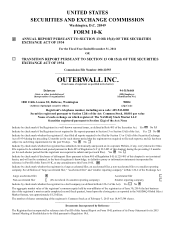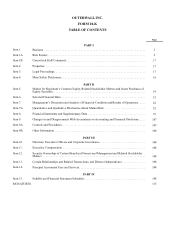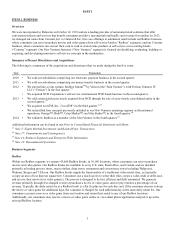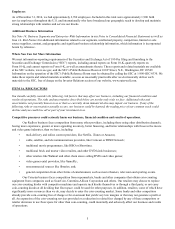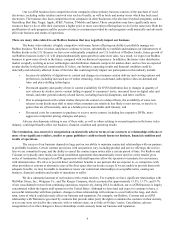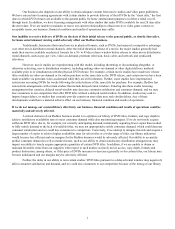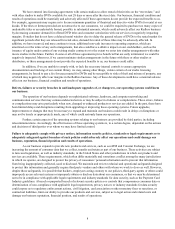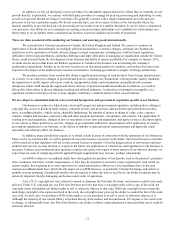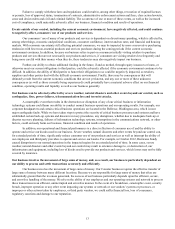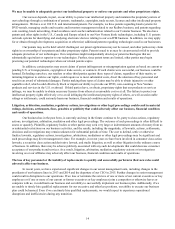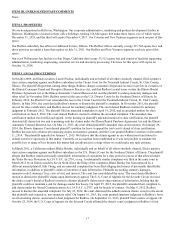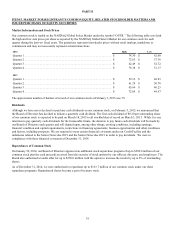Redbox 2014 Annual Report Download - page 17
Download and view the complete annual report
Please find page 17 of the 2014 Redbox annual report below. You can navigate through the pages in the report by either clicking on the pages listed below, or by using the keyword search tool below to find specific information within the annual report.9
Our failure to meet consumer expectations with respect to pricing our products and services may adversely affect our
business and results of operations.
Demand for our products and services may be sensitive to pricing changes. We evaluate and update our pricing
strategies from time to time, and changes we institute may have a significant impact on, among other things, our revenue and
net income. For example, in December 2014 the rental price for DVDs increased by 30 cents to $1.50 a day, the price for
Blu-ray Discs increased by 50 cents to $2.00 a day, and in January 2015, the rental price for video games increased by $1.00 to
$3.00 a day. In the future, other fee increases or pricing changes may deter consumers from using our kiosks or reduce the
frequency of their usage.
Payment of increased fees to retailers or other third party service providers could negatively affect our business results.
We face ongoing pricing pressure from our retailers to increase the service fees we pay to them on our products and
services or to make other financial concessions to win or retain their business. If we are unable to respond effectively to
ongoing pricing-related pressures, we may fail to win or retain certain accounts. Our fee arrangements are based on our
evaluation of unique factors with each retailer, such as total revenue, long-term, non-cancelable contracts, installation of our
kiosks in high-traffic, geographic locations and new product and service commitments. Together with other factors, an increase
in service fees paid, or other financial concessions made, to our retailers could significantly increase our direct operating
expenses in future periods and harm our business. In addition, we accept payment for movie and game rentals through debit and
credit card transactions. For these payments, we pay interchange and other fees, which have increased and may increase further
over time. Further, because Redbox processes millions of small dollar amount transactions, and interchange fees represent a
larger percentage of card processing costs compared to a typical retailer, we are relatively more susceptible to any fee increase.
When interchange or other fees increase, it generally raises our operating costs and lowers our profit margins or requires that
we charge our customers more for our products and services.
We may be unable to attract new partners, broaden current partner relationships, and penetrate new markets and
distribution channels.
To increase our kiosk installations, we need to attract new partners, broaden relationships with current partners, and
develop operational efficiencies that make it feasible for us to penetrate lower density markets or new distribution channels,
such as Coinstar kiosks in banks and credit unions and ecoATM kiosks in grocery locations. We may be unable to attract new
retailers or drive down costs relating to the manufacture, installation or servicing of our kiosks to levels that would enable us to
operate profitably in lower density markets or penetrate new distribution channels. If we are unable to do so, our future
financial performance could be adversely affected.
Our future operating results may fluctuate.
Our future operating results will depend significantly on our ability to continue to drive new and repeat use of our
Redbox and Coinstar kiosks, our ability to develop and commercialize new products and services, such as ecoATM, and the
costs incurred to do so, and our ability to successfully integrate acquisitions and other third-party relationships into our
operations. Our operating results have a history of fluctuating and may continue to fluctuate based upon many factors, including
fluctuations in revenue generated by and operating expenses incurred by our different lines of business, seasonality, the timing
of the release slate and the relative attractiveness of the titles available for rent in a particular quarter or year which may have
lingering effects in subsequent periods, fluctuations in consumer rental patterns, including the number of movies rented per
visit, the type of DVDs they want to rent and for how long, and the level of DVD migration between kiosks.
We have historically experienced seasonality in our revenue from our Redbox segment. December and the summer
months have historically been high rental months. April has been a low rental month due, in part, to retail release timing in
connection with the Academy award ceremonies and the Easter holiday that historically has provided stronger content and
resulted in higher rentals in March. September and October have been low rental months, due, in part, to the beginning of the
school year and the introduction of the new fall television season. However, we have entered into licensing agreements with
certain studios that contain delayed rental windows. This has shifted the availability of titles affected by the delayed rental
windows relative to historic patterns. Seasonal effects, however, may be minimized or increased by the actual release slate and
the relative attractiveness of movie titles in a particular quarter or year which may have lingering effects in subsequent periods.
Our Coinstar segment generally experiences its highest revenue in the second half of the year due to increased retailer foot
traffic and holiday shopping in the fourth quarter and an increase in consumers’ desire for disposable income in the summer
months. In our New Ventures segment, seasonality generally peaks during the summer months, declines in the fourth quarter
and remains flat into the following quarter before increasing in late February but can be significantly impacted by the timing of
new phone releases.


